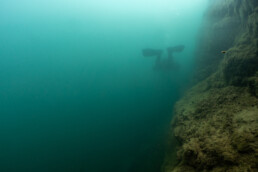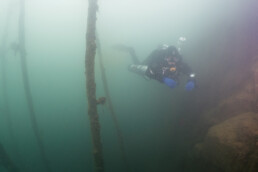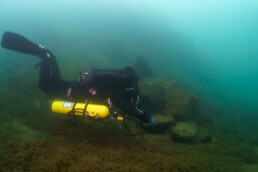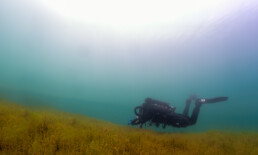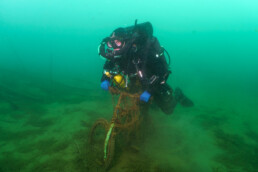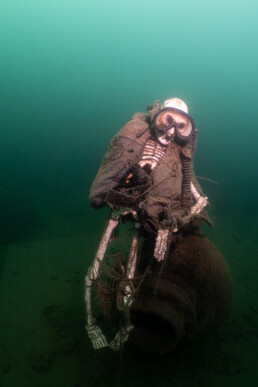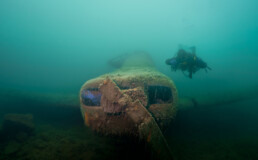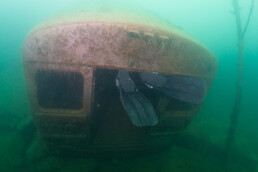Into the Quiet: Diving Deep in Spring’s Strange Waters
In the last few weeks, we’ve been revisiting the depths of Lake Ore-be-gone, nestled just outside Gilbert, Minnesota. It’s a place with a name that sounds like something from sound set of “a Prairie home Companion” (which is kinda of is) and water that, depending on the year, might resemble either Caribbean blue or day-old dishwater. This day was the later.
This spring began inauspiciously. Our first foray in early May was met with truly appalling visibility—less than five feet in places where we’re used to thirty. The culprit? A curious phenomenon known as lake turnover. When a body of water shrugs off its icy winter coat, it undergoes a seasonal inversion, flipping its temperature layers like a flapjack. It’s all thanks to a peculiar property of H₂O: unlike most substances, water is densest not when frozen but at precisely 39.2°F. Below that, it actually becomes less dense. This oddity is why ice floats, why fish survive winter, and—more relevant to us—why springtime visibility in a lake can look like dishwater in need of some Dawn.
But, compared to Lake Superior’s glacial embrace, the mid-40s water temperatures felt positively spa-like so we weren’t complaining. And here’s the thing about cold water: it doesn’t just chill your fingers, it fogs your brain. Reduced concentration, poor coordination, a sort of underwater brain fog—it’s a thing. I’ve felt it more than once this winter, fumbling my way through the tail end of a dive with numb, club-like hands and a less than nimble brain. So 45°F felt, positively warm. But the real story is Heather.
Last week, she completed her MOD 1 training, as a certified closed-circuit rebreather diver. It’s the first of three courses that eventually get you to diving to 100 meters. It’s a week long course and is the SCUBA equivalent of trading in your bicycle for a spaceship. Rebreathers don’t vent bubbles. They recycle your breath, stripping carbon dioxide, replenishing oxygen, and looping it back through. It’s nearly silent, dramatically more efficient, wildly more complicated and a bit unnerving at first.
On traditional SCUBA, your buoyancy subtly adjusts with every breath—inhale and you rise, exhale and you sink. It’s intuitive. On a rebreather? That delicate dance is gone. Your lungs are now part of a loop. Exhale, and instead of shedding air to the water column, you’re just moving breath around. There is no feedback loop of float and fall—only the slow, silent, slightly alien process of pure suspension. Which is, eventually amazing, but requires you to forget years of hard earned open circuit buoyancy skills. Until then, you are and look like a total beginner – humbling to say the least.
So ya, It’s weird and hard. Then it’s wonderful.
So there we were, easing into the north side of Ore-be-gone on a quiet Monday, and Heather was about to do something momentous—her very first dive after rebreather certification. It was a bit like driving on your own for the first time after driver’s ed: thrilling, slightly nerve-wracking, and made just a touch more exciting by the possibility of accidentally drifting into a metaphorical ditch. She had a few minor hiccups—a little weight adjustment here, a drysuit inflator that seemed determined to turn her into a Thanksgiving Day parade float—but she took it all in stride, calm and unflappable, like she’d been doing this for years.
Yesterday, we went back.
It was a Saturday—which, given my schedule, felt like a minor holiday. I had requested it off months earlier to help my siblings with a landscaping project for our parents, a Christmas gift of botanical benevolence. My Dad, known for his work ethic and sadly for a failing lumbar spine, and lower extremity circulatory system had other plans. These days he struggles just to get up and down the steps, but despite this, he got out there on his hands and knees, pulled shrubs, planted grass, and moved paver stones. And as always, just got it done. So, with the landscaping projected complete I ended up with a free Saturday. So I went diving.
Lake Ore-be-gone, usually as quiet as confession booth on a Super Bowl Sunday, was oddly lively that day—a speedboat, a fishing crew, a few kayakers all sharing the backroad access. Everyone was friendly, all waves and hellos, but clearly unfamiliar with the red-and-white dive flag bobbing beside us. We offered a polite reminder that it’s not just for decoration—it means there are actual people underwater, and that spinning propellers above them are, well, less than ideal. Most boaters mean well, but you’d be surprised how many think the flag signals a good place to boat, rather than a place to steer well clear of.
Heather was still getting accustomed to her new rebreather, so I took point trying to look capable while juggling my king crab sized camera rig and always aggravating dive flag. We descended first to the sunken helicopter (yes, there’s a helicopter), where I managed a decent photo of Heather peering through the cockpit window. Then past the airplane (yep, there’s an airplane too) resting at 50 feet, where visibility dipped again. From there we swam slowly along the southern wall of the lake, hovering just above the thermocline where the water stayed in the low 50s. The sunlight dappled the lake bed like some ancient cathedral stained glass, broken into a thousand waving fragments by the surface. We drifted—silent, suspended, serene.
Eventually, reluctantly, I signaled to turn the dive. My CO₂ scrubber was over an hour past its rated limit. These ratings are famously squishy—affected by temperature, workload, and other variables—but one thing’s for sure: hypercapnia is not on anyone’s to-do list.
We surfaced to a now-empty lake. Boats gone. Kayaks loaded. The water calm.
Then Heather noticed something: her glasses were gone. Normally tucked securely in a drysuit pocket, zipped and stowed—but not today. They likely missed the pocket entirely, dropped at the beginning of the dive. Visibility in the shallows, churned by all the weekend activity, was now down to a few inches. We searched briefly, stirred up silt, and surrendered.
Luckily, she’d already planned a to dive the following day. Now it would double as an underwater spectacle recovery mission.
So here we are, the lake is finally starting to clear up again, bit by bit, like someone slowly wiping the fog off a window. I even heard—from that wellspring of all reliable knowledge, Facebook—that the water levels, after years of stubborn retreat, might actually be creeping back up. Meanwhile, Heather has officially joined the rebreather club, which means we can now glide around underwater in near silence, drifting for hours in what feels like an enchanted, submerged forest. The fish, no longer scatter at the sound of our breathing. All told, I have a feeling this summer’s going to be pretty good.

